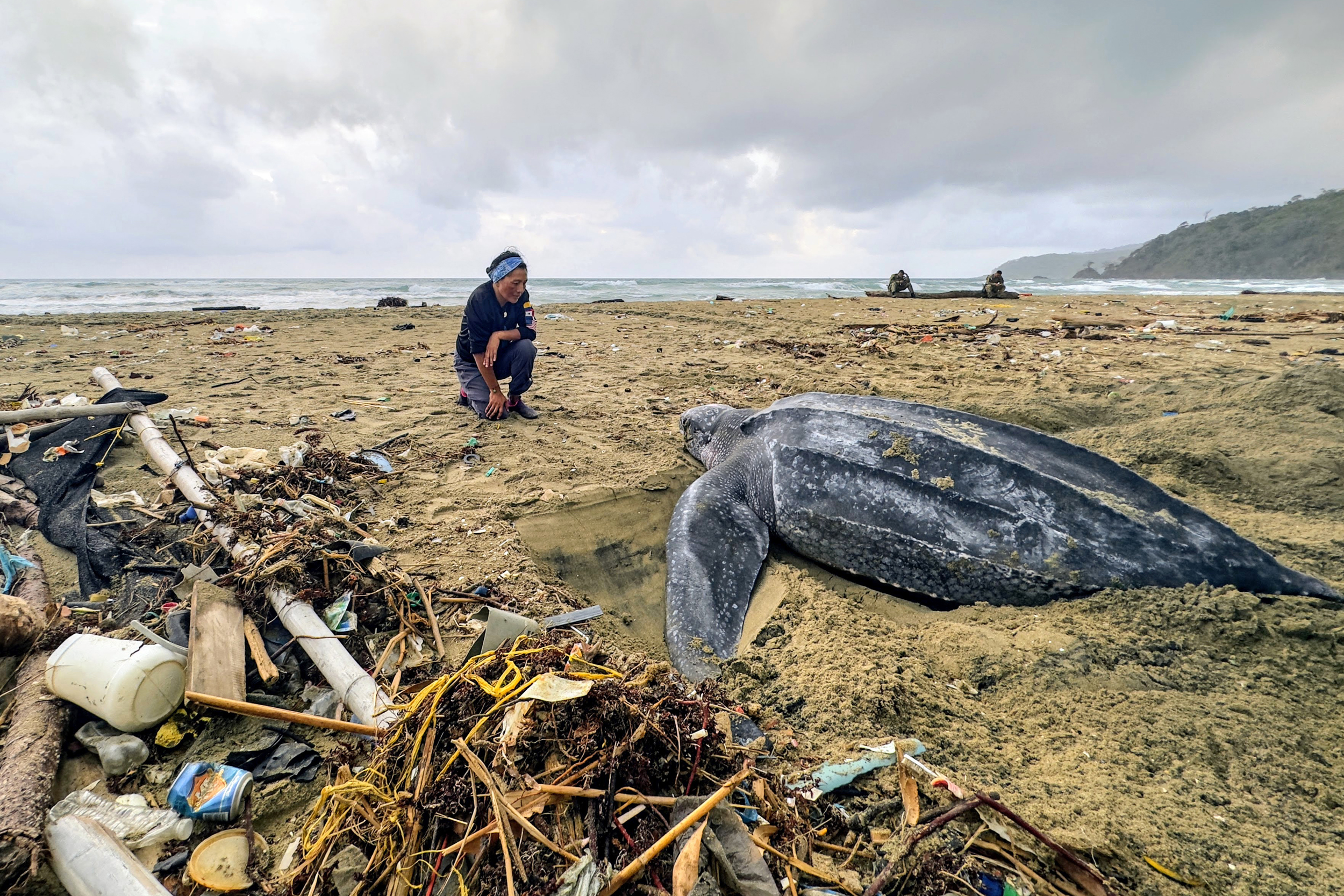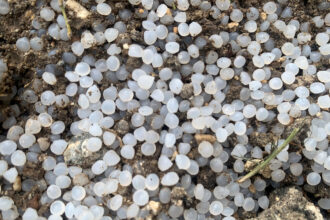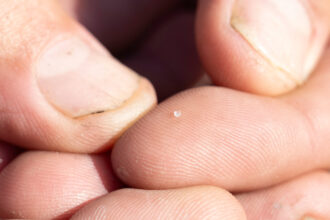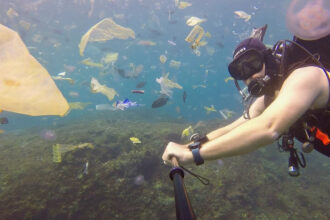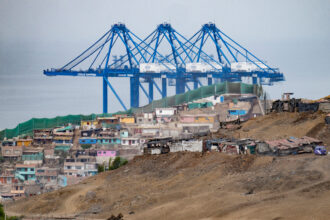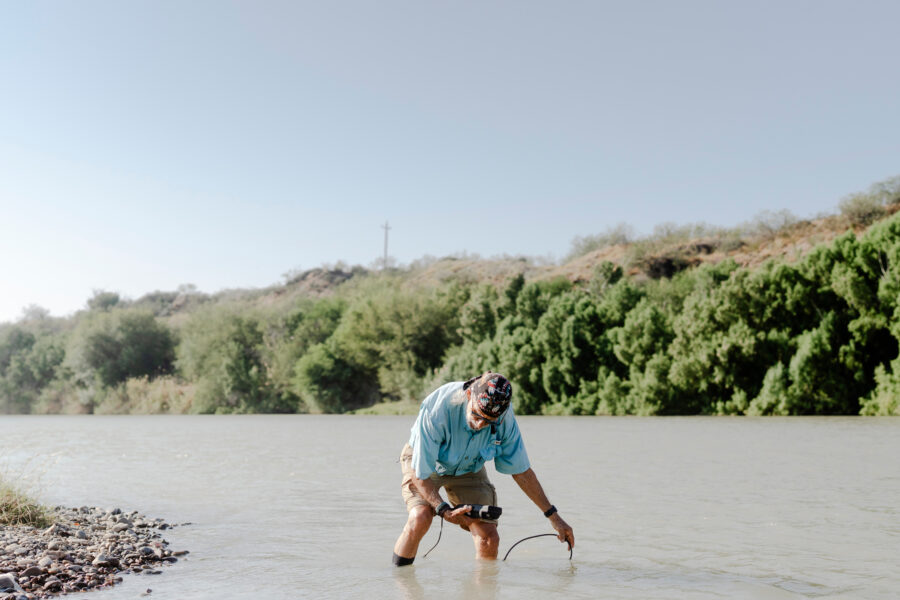Ingesting just six pieces of rubber—each smaller than a pea—can all but seal a seabird’s fate, leaving it with a 90 percent chance of death. A 300-pound adult green sea turtle has about a 50 percent chance of survival after swallowing two golf balls’ worth of plastic bags and food wrappers. Gulping down less than a soccer ball’s volume of fishing line or nets is enough to kill nearly all sea lions, seals, dolphins and porpoises.
These are just some of the fatal thresholds marine wildlife face when plastic ends up inside their bodies, according to a new analysis by scientists from the Ocean Conservancy, an international marine conservation nonprofit. In a study released Monday, researchers outline the amount of swallowed debris it takes to block an animal’s gut, tear its digestive tract or force its intestines to twist.
“We have long known that consuming plastics can kill ocean animals,” said the study’s lead author, Erin Murphy, who manages Ocean Conservancy’s ocean plastics research. “What we didn’t know before is how much plastic is too much.”
That answer came into focus after Murphy and her colleagues reviewed more than 10,000 reports detailing the deaths of sea turtles, seabirds and marine mammals worldwide—cases where both the cause of death and the amount of plastic inside the animals’ bodies were known. The pattern was clear: Exposure to macroplastics, bigger than the width of a pencil, is widespread and often deadly for animals studied, even in small quantities.
“The lethal dose varies based on the species, its size, the type of plastic it’s consuming, and other factors, but overall it’s much smaller than you might think, which is troubling when you consider that more than a garbage truck’s worth of plastics enters the ocean every minute,” Murphy said in a press release.
Marine animals swallow plastic for a variety of reasons, said Matthew Savoca, a plastics researcher at Stanford University’s ocean lab, the Hopkins Marine Station. Some mistake it for food because it looks, smells or even sounds like something they normally eat. “They may ingest it because they’re young and still learning how to forage, or because they’re malnourished and desperate,” he said. Others accidentally swallow it because it’s attached to prey or already inside the fish they eat.
While various previous studies have tried to quantify and describe the impact of ingested plastic on certain species, this latest study is the most comprehensive, according to Savoca, who was not involved in the research. “It provides the best estimate I am aware of for the overall death rate, at a population level, that is attributable to macroplastic ingestion,” he said, calling the findings “vital information for conservationists.”

Britta Baechler, director of ocean plastics research at Ocean Conservancy and co-author of the study, said the findings offer a roadmap for action. “This is really important for pushing policy work,” she said, because the results pinpoint which materials pose the greatest risks to wildlife. “We are figuring out which plastics are most problematic.”
The shape and make of a plastic item often dictates the damage it can do. Thin monofilament fishing line tends to knot and twist through the intestines, for instance, while sharp-edged fragments from larger broken pieces can pierce internal organs.
“We want people to understand that by cleaning up and removing plastics from shorelines, from inland areas [and so on], you really are making a difference,” Baechler said. “We know if one of these species consumes a piece of plastic that originated from shore it can really lead to negative outcomes.”
Sea turtles show just how high the stakes are. The study found that nearly half of all dead turtles examined had plastic inside their bodies, compared to 35 percent of seabirds and 12 percent of marine mammals found with trash in their guts. The research also shows that marine turtles are more likely to die from swallowing debris than any other group. And the youngest ones are most vulnerable.
In their early lives, sea turtle hatchlings and juveniles feed on crustaceans, insects and algae at the water’s surface, where plastic fragments collect. “In those baby sea turtles we saw like hard plastic fragments that are more often seen off the coast, in the open ocean, and also like smaller pieces of film,” Murphy said.
As turtles grow and move into coastal and reef habitats, their diets and the debris they encounter shift, with adults more likely to swallow full plastic bags or fishing gear that they confuse for prey like jellyfish.
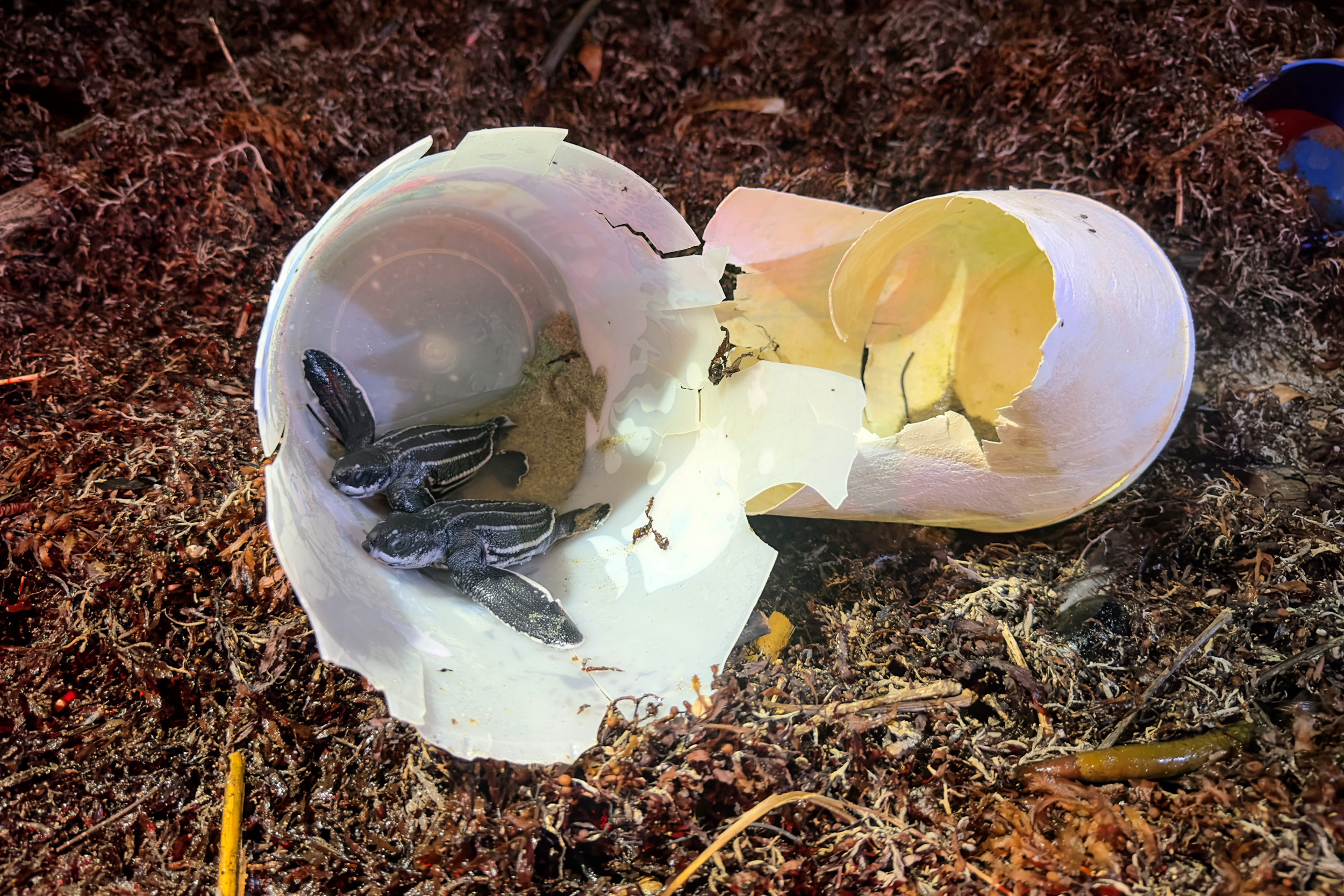
Some leatherback sea turtles that have been found dead had an array of items in their stomachs, including rope, fragments of shopping bags, bottle caps, a potato chip bag, two plastic cans, a plastic belt and even a hygienic pad, Baechler said.
Another turtle had a piece of fishing line that stuck out its mouth and went all the way through its intestinal tract. But according to the study, swallowing even small fragments of these larger items can be devastating. If an adult turtle eats more than 300 pieces of soft plastics, each no bigger than a grain of corn, it has a 90 percent chance of dying.
For seabirds, rubber objects like balloons are especially dangerous. “Roughly a third of seabirds that ingested some piece of balloon died from it,” the study’s lead author, Murphy, said. Their stretchy, pliable texture allows them to lodge in the gastrointestinal tract, disrupting the passage of food. “They seem to kind of get stuck in there because of their shape,” she said. Some animals may stop eating because they already feel full of plastic.
This story is funded by readers like you.
Our nonprofit newsroom provides award-winning climate coverage free of charge and advertising. We rely on donations from readers like you to keep going. Please donate now to support our work.
Donate NowMarine mammals, like dolphins, may swallow fishing gear, like hooks, lines or pieces of nets, while trying to eat fish caught in it. Larger whales, which engulf entire schools of prey at once, can take in enormous amounts of debris in the process. In the case studies Murphy looked at, she said she came across accounts of dead whales with hundreds of pounds of nets inside their stomachs. Some of them had consumed pieces of hoses, gardening equipment and clothing. In one case, a sperm whale swallowed a three-gallon bucket.
It’s important to note, Murphy said, that ingestion is just one of the ways animals are affected by plastic pollution. This study, for example, did not account for the impacts of microplastics and the chemicals associated with them, or the entanglement and entrapment of animals in plastic debris, both on land and in the ocean.
“We know that seabirds, marine mammals and sea turtles all get entangled in primarily fishing gear, but also in some consumer plastics, like plastic bags,” Murphy said.
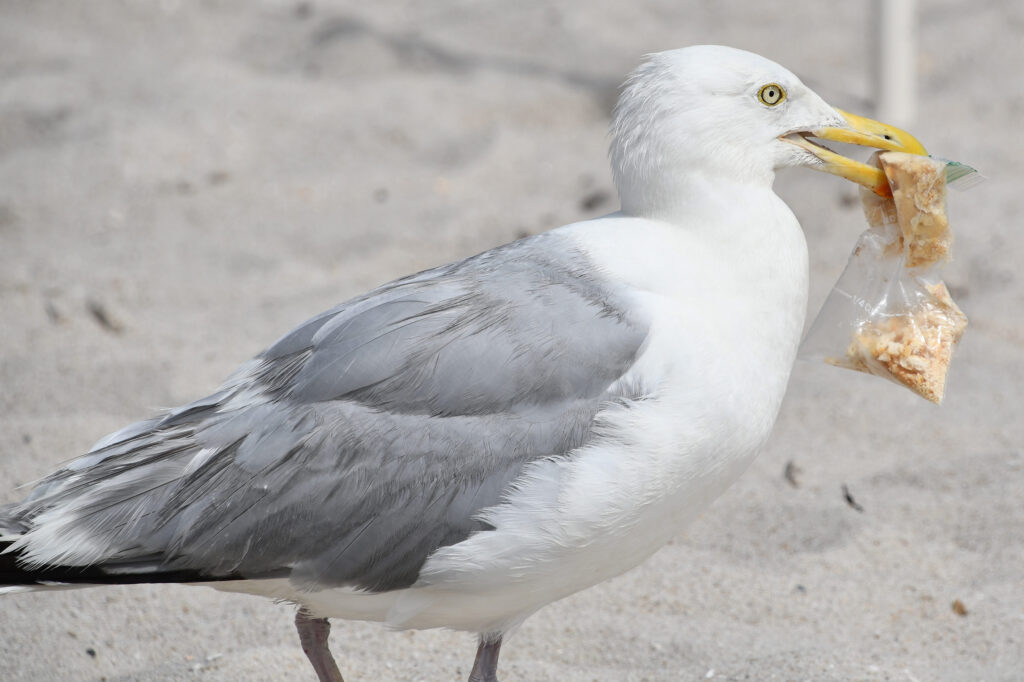
Baby turtles also become trapped in plastic litter entrenched in their nests and along the beaches they must crawl across to reach the ocean for the first time, she said. This can leave them exposed and more vulnerable to predators like birds, crabs and dogs.
Scientists estimate more than 11 million metric tons of plastics enter the ocean every year, according to the Ocean Conservancy. And most of them are single use items, from plastic bags and foam packaging, to food labels, takeout containers, straws and utensils.
According to Anja Brandon, director of Ocean Conservancy’s Plastics Policy Program, her colleagues’ latest research is going to be critical in providing the evidence needed to push policy makers to hold manufacturers of plastic materials accountable.
Their findings, she said, strengthen the case for laws that begin to place a financial burden onto companies that produce these materials, making it more expensive for them to flood the market with items that are difficult to recycle or are likely to escape into the environment.
“It is going to cost more to make a plastic product that is hard to recycle than to eliminate that plastic or switch to a reusable or switch to paper or something else that might be less environmentally harmful,” she said.
Policies such as plastic bag bans and balloon-release bans are already expanding across the United States and some other countries.
New policies, she said, should continue to focus on reducing and eliminating some of the most deadly products when animals interact with them, according to the latest research “starting with the plastics that we know disproportionately end up on our beaches, in our waterways, in the ocean, that are having some of the most impact on animals.”
About This Story
Perhaps you noticed: This story, like all the news we publish, is free to read. That’s because Inside Climate News is a 501c3 nonprofit organization. We do not charge a subscription fee, lock our news behind a paywall, or clutter our website with ads. We make our news on climate and the environment freely available to you and anyone who wants it.
That’s not all. We also share our news for free with scores of other media organizations around the country. Many of them can’t afford to do environmental journalism of their own. We’ve built bureaus from coast to coast to report local stories, collaborate with local newsrooms and co-publish articles so that this vital work is shared as widely as possible.
Two of us launched ICN in 2007. Six years later we earned a Pulitzer Prize for National Reporting, and now we run the oldest and largest dedicated climate newsroom in the nation. We tell the story in all its complexity. We hold polluters accountable. We expose environmental injustice. We debunk misinformation. We scrutinize solutions and inspire action.
Donations from readers like you fund every aspect of what we do. If you don’t already, will you support our ongoing work, our reporting on the biggest crisis facing our planet, and help us reach even more readers in more places?
Please take a moment to make a tax-deductible donation. Every one of them makes a difference.
Thank you,


